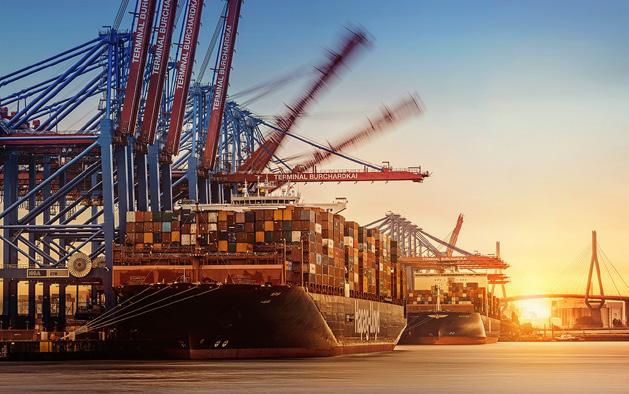
4 minute read
The Big Ships are Coming
The order book for high-capacity container vessels is bursting at the seams. It’s too early, however, as Mike Mundy reports, to suggest this will trigger a return to pre-pandemic market conditions
The big ships are coming – well that’s for sure.
The top end of the world container fleet – vessels of 14,000TEU and upwards – is set to see an injection of new capacity of 3,300,800TEU, just a tiny bit shy of half of the combined capacity of the existing fleet – 6,665,000TEU – that sits above the 14,000TEU mark. Figure 1, recently compiled by Dynaliners, tells the story, breaking down vessels on order and now operational into four categories in tranches of 2000TEU upwards from 14,000TEU.
The largest number of vessels, both on order and operational, fall in the 14,000 – 15,999TEU range. Interestingly, the 18,000 to 21,999TEU segment has not been the subject of new orders – the consensus of opinion being that this category has been passed over in favour of 22,000+TEU vessels, typically offering stowage of 24 containers wide on-deck.
The remarkable thing is, as Dynaliners confirms, the orders continue to flow in – with the 16,000 – 18,000TEU range identified as a likely strong beneficiary in this respect.
The ‘Order Fest’ that has been underway recently and which continues today is a remarkable one and the big question on everyone’s lips is, what happens when the vast majority of these high capacity vessels set sail? Will it realise a dramatic alteration in the supply/demand balance that will be instrumental in driving freight rates down?
There is already movement in the latter respect. Inflation is pushing consumer demand down, as is a fall in available exports due to lockdowns in China – the net result being a fall in ocean rates, although they still remain a long way away from 2019 levels. Some estimates suggest that Asia – US West Coast freight rates have fallen by around 50 per cent in Q2 and that Asia North Europe rates are 30 per cent lower than the beginning of the year. This is not the case across the board, however, with Europe – US East Coast rates identified as over 40 per cent higher than a year ago and four times higher than pre-pandemic levels.
The reality also remains of stop-start supply chains generating erratic cargo flows. There is still port congestion and this promises to be further aggravated by dock worker strikes in northern Europe and the UK. At the time of writing, it had just been announced that workers at the UK port of Felixstowe, the country’s largest volume container handler, had rejected a pay offer of five per cent and more or less unanimously voted to strike. This follows hot on the heels of the threat of industrial action at the port of Liverpool UK and increasingly bitter port strikes in Germany.
Labour negotiations on the US West Coast are reportedly going well but nothing is guaranteed plus there are labour issues bubbling among Canadian and US rail employees which also have the potential to reap havoc on logistic chains.
SHORT-TERM SCENARIO
The short-term scenario for freight rates points to a downward trend but will 2022 see a major drop? This is unlikely – the disruptive factors identified above are still much in evidence and promise to continue to play their part in making the task of getting goods to market on-time at the right price both problematic and expensive compared to 2019 conditions.
This is further evidenced in the financial forecasts of liner operators – Hapag Lloyd for example while reporting a strong first half of 2022 – revenue increased by 51 per cent to USD10.6 billion and group profit came in at USD3.3 billion – expects earnings to be strong in the second half of the year. EBITDA for the full year, according to the company, is expected to be in the range of USD 9.2 to 11.2 billion and EBIT to be in the range of USD 7.5 to 9.5 billion. As regards, what is enabling it to achieve this positive position, tellingly Hapag Lloyd puts the spotlight on ongoing positive demand, a congested operating environment and a shortage of weekly transport capacity – mainly the disruptive factors.
What does this mean for ports? In a nutshell, a continuing challenging environment and with more big ships coming, and the real possibility of large capacity vessels cascading down into secondary trades, the ongoing need to invest to ensure the presence of the right capacity and the ability to deliver higher levels of efficiency.
Looking a little further ahead, mid-2023 onwards, the outlook may be the focus of significant change by then – this is when a number of market analysts contend that massive new shipping capacity, weak demand and eased congestion will see the balance shift firmly in favour of cargo owners.
8 Hapag Lloyd’s
15,000TEU capacity Afif sits in the most popular category of high capacity vessels
8 Figure 1: Vessel
Categories above 14,000TEU Capacity – Operational and On Order
Size Category Operational No Orders
TEU No TEU
14,000 – 15,999 149
16,000 - 17,999 39 2,166,700 120 1,810,200
633,700 49 794,100
18,000 - 21,999 105 2,072,600 - -
22,000 - 73 1,763,100 30 696,600








